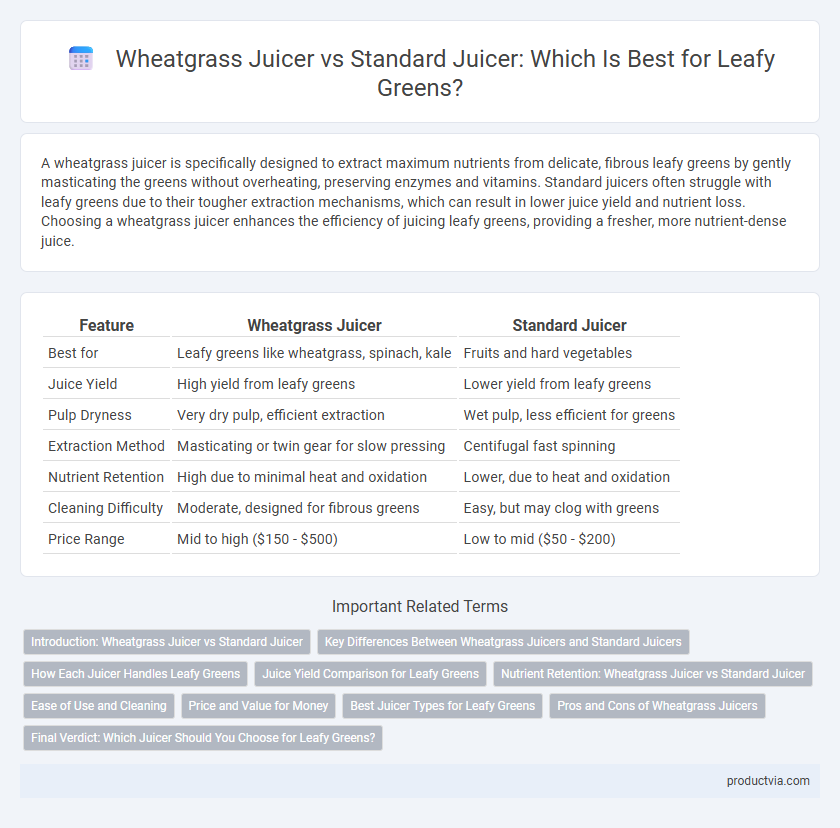A wheatgrass juicer is specifically designed to extract maximum nutrients from delicate, fibrous leafy greens by gently masticating the greens without overheating, preserving enzymes and vitamins. Standard juicers often struggle with leafy greens due to their tougher extraction mechanisms, which can result in lower juice yield and nutrient loss. Choosing a wheatgrass juicer enhances the efficiency of juicing leafy greens, providing a fresher, more nutrient-dense juice.
Table of Comparison
| Feature | Wheatgrass Juicer | Standard Juicer |
|---|---|---|
| Best for | Leafy greens like wheatgrass, spinach, kale | Fruits and hard vegetables |
| Juice Yield | High yield from leafy greens | Lower yield from leafy greens |
| Pulp Dryness | Very dry pulp, efficient extraction | Wet pulp, less efficient for greens |
| Extraction Method | Masticating or twin gear for slow pressing | Centifugal fast spinning |
| Nutrient Retention | High due to minimal heat and oxidation | Lower, due to heat and oxidation |
| Cleaning Difficulty | Moderate, designed for fibrous greens | Easy, but may clog with greens |
| Price Range | Mid to high ($150 - $500) | Low to mid ($50 - $200) |
Introduction: Wheatgrass Juicer vs Standard Juicer
Wheatgrass juicers are specifically designed to efficiently extract juice from fibrous leafy greens like wheatgrass by using a slow, masticating process that preserves nutrients and maximizes yield. Standard juicers, especially centrifugal models, often struggle with leafy greens, producing lower juice yield and more foam due to their high-speed spinning. Choosing a wheatgrass juicer ensures higher nutrient retention, less oxidation, and a smoother juice texture ideal for leafy green consumption.
Key Differences Between Wheatgrass Juicers and Standard Juicers
Wheatgrass juicers feature specialized masticating mechanisms designed to efficiently extract juice from fibrous leafy greens, resulting in higher nutrient retention and juice yield compared to standard centrifugal juicers. Standard juicers often struggle with leafy greens due to high fiber content, leading to lower juice quality and increased pulp waste. The slow, cold-press operation of wheatgrass juicers preserves enzymes and antioxidants, making them ideal for producing nutrient-dense green juices.
How Each Juicer Handles Leafy Greens
Wheatgrass juicers utilize a slow masticating process that efficiently extracts juice from leafy greens by crushing and grinding the fibers, resulting in higher nutrient retention and minimal oxidation. Standard centrifugal juicers rely on fast-spinning blades that often leave leafy greens partially unprocessed, producing less juice with more foam and oxidation. For leafy greens, wheatgrass juicers consistently yield a higher juice output with better preservation of enzymes and vitamins.
Juice Yield Comparison for Leafy Greens
Wheatgrass juicers are specifically designed to maximize juice yield from leafy greens by using slow masticating technology that efficiently crushes and presses fibers. Standard juicers, often centrifugal, tend to produce lower juice yield with leafy greens due to higher heat and faster spinning, which can lead to oxidation and nutrient loss. For optimal extraction and higher nutrient retention in wheatgrass and other leafy greens, wheatgrass juicers consistently outperform standard juicers in juice yield and quality.
Nutrient Retention: Wheatgrass Juicer vs Standard Juicer
Wheatgrass juicers excel at nutrient retention for leafy greens by using slow, cold-press extraction, which minimizes heat and oxidation that degrade vitamins and enzymes. Standard juicers, particularly centrifugal models, often generate heat and introduce air, resulting in reduced nutrient quality and shorter shelf life of the juice. Choosing a wheatgrass juicer ensures maximum preservation of chlorophyll, antioxidants, and essential enzymes essential for health benefits.
Ease of Use and Cleaning
Wheatgrass juicers are specifically designed with slow, masticating mechanisms that efficiently extract juice from leafy greens, making them easier to use for this purpose compared to standard centrifugal juicers. Their compact design and fewer parts simplify cleaning, reducing residue buildup that is common with the larger strainers of standard juicers. Standard juicers often require more time for disassembly and cleaning due to mesh filters and multiple components trapping fibers from leafy greens.
Price and Value for Money
Wheatgrass juicers are specifically designed to efficiently extract juice from leafy greens, providing higher yield and nutrient retention compared to standard juicers, which often struggle with fibrous greens. While wheatgrass juicers tend to have a higher initial cost, their optimized performance for leafy greens offers better value for money through less wastage and enhanced juice quality. Standard juicers are generally more affordable but may require more frequent use and cleanup, reducing overall efficiency and return on investment for leafy green juicing.
Best Juicer Types for Leafy Greens
Wheatgrass juicers are specifically designed with slow, cold-press masticating mechanisms that efficiently extract juice from fibrous leafy greens, preserving maximum nutrients and enzymes. Standard centrifugal juicers operate at high speeds that generate heat, causing oxidation and reducing nutritional value when processing delicate greens. For optimal nutrient retention and higher juice yield from wheatgrass and other leafy greens, masticating or triturating juicers outperform standard centrifugal models.
Pros and Cons of Wheatgrass Juicers
Wheatgrass juicers are specifically designed to efficiently extract juice from leafy greens, preserving more nutrients and enzymes compared to standard juicers. Their slow masticating mechanism minimizes oxidation and heat build-up, resulting in higher-quality juice with a richer nutrient profile, though they tend to be more expensive and require more time for thorough cleaning. Standard juicers often process a wider variety of fruits and vegetables faster but may produce lower yields and more foam when juicing delicate leafy greens like wheatgrass.
Final Verdict: Which Juicer Should You Choose for Leafy Greens?
Wheatgrass juicers excel at extracting maximum nutrients and juice yield from leafy greens due to their slow, masticating mechanism that preserves enzymes and vitamins better than standard centrifugal juicers. Standard juicers, while faster and more versatile for fruits and hard vegetables, often produce lower-quality juice with more foam and oxidation when processing leafy greens. Choosing a wheatgrass juicer provides superior juice quality and nutrient retention specifically for leafy greens, making it the preferred option for health-conscious users focused on green juice benefits.
Wheatgrass juicer vs Standard juicer for leafy greens Infographic

 productvia.com
productvia.com